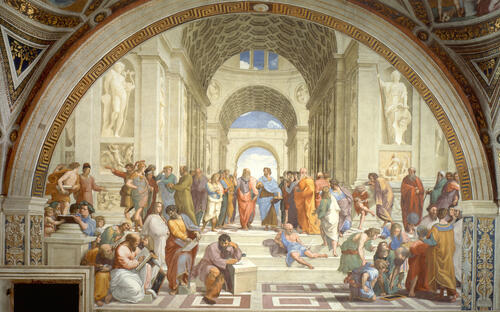
Renaissance is a French word meaning ‘rebirth’, and in this case, it refers to the rebirth of the ideas and culture of Classical Greek and Roman civilization. The Renaissance took place in Western Europe and marked the beginning of the end of the Middle Ages. Basically, Europeans were growing more and more tired of going medieval on each other.
Most European Medieval art was created by anonymous craftsmen in the service of the Catholic Church. A lot of it was meant to instill the fear of God in the average, illiterate viewer. But things changed in the Renaissance. The world became larger as global trade increased, cities grew, and patrons other than the Church could suddenly afford to commission art. At the same time, humankind's relationship to God, the world, and the Cosmos was being redefined. Whereas Medieval man toiled in the fields of his feudal lord and lived in terror of the Day of Judgment, a new movement called Humanism promoted more "earthly" pursuits such as education, ethical living, and individual ability. This is why we know the names of artists from the Renaissance. They finally started getting some of the glory for their work.
The Renaissance began in the fourteenth century, and Florence, Italy was its hotbed. Urban intellectuals studied the Roman ruins around them, rediscovered Classical Latin texts, and modeled their own poetry and art after the balance and beauty of that of their Classical forebears. At the same time, the nature of the physical world became a subject worthy of study, and artists became more interested in accurately depicting the world around them, leading to the discovery of single-point-perspective.
The Northern European Renaissance was fueled by some of the same intellectual ideas as the Southern, but was distinctive for the rise in the use of oil paint, which allowed artists to create meticulously detailed, realistic images. Furthermore, the invention of the printing press in Germany allowed books and images to be disseminated far and wide, so when the Reformation came along, new ideas about art and religion were able to spread easily. Distrust of idealized religious imagery would end up leading to an increase in images depicting modern life, often with a moralizing tone, in Germany and the Low Countries.
For this class, we will study the Northern European Renaissance figures such as Gutenberg, Dürer, Holbein and van Eyck, and the Southern European Renaissance artists such as Giotto, the Teenage Mutant Ninja Turtles (Leonardo, Donatello, Michelangelo and Raphael), Brunelleschi, and Fra Angelico. Many of these artists were not just artists, but also writers, politicians, scientists and philosophers, and they helped usher in the beginning of the age of enlightenment and the development of the scientific method.
List of Key Renaissance artists
Northern Renaissance:
- Jan van Eyck - Hailed as the inventor of oil painting
- Robert Campin - the "Master of Flémalle"
- Rogier van der Weyden - Early Netherlandish master
- Hans Holbein the Younger - Court artist to Henry VIII
- Hieronymus Bosch - Painter of the fantastic and ironic
- Pieter Bruegel the Elder - Cynic and Humanist Painter
- Martin Schongauer - German Engraver; see more of his work here.
- Albrecht Dürer - Painter, Businessman, and one of the first artists to use typography as an art form
- Check out his typography book, "Of the Shaping of the Letter," here.
Southern Renaissance:
- Giotto - The first "Renaissance Man"
- Fra Angelico - A Dominican monk and painter
- Leonardo da Vinci - An all around over-achiever
- Donatello - A prolific sculptor
- Michelangelo - Sculptor, painter, architect, poet
- Raphael - Star boy of the Renaissance
- Brunelleschi - A goldsmith turned architect and Renaissance poster-child
- Sandro Botticelli - Painter of myths
This reader is part of a larger series of introductory texts about art and art history. Each has been written under the direction of Rick Love. This reader was co-authored by Jeannette Sturman.
Comments (5)

I like how the colors are not too bright as to distract someone from the whole piece. This way you can enjoy, and look at all the small pieces in the art work without being distracted. I think that the shading gives the artwork a lot of depth, as the building is very large.

Art history is the biggest saving of life one could ever wish for.

This is awesome! Will there be more? My wife wants to know what type of painting they did in Italy "if they did oil painting in the north, what type did they do in the south?" I said Fresco of course. : )

Some good stuff on the Italian Renaissance here: https://www.sartle.com/blog/post/sartle-school-of-art-history-the-itali…











I remember how I had to write very difficult papers on the development of the Renaissance and this era in general.